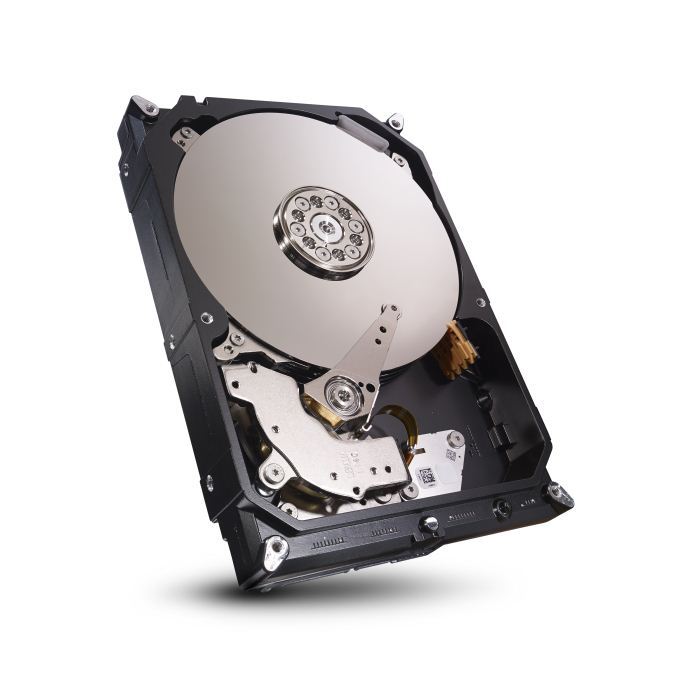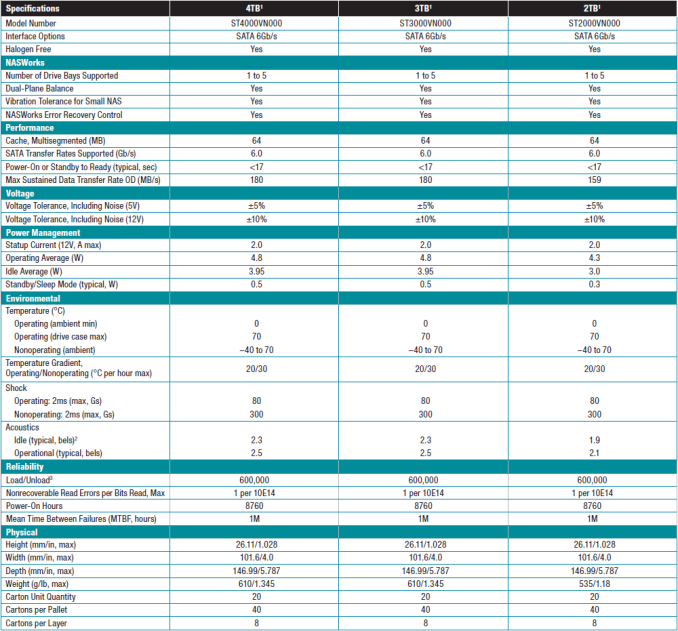Seagate Introduces NAS HDD: WD Red Gets a Competitor
by Ganesh T S on June 11, 2013 8:01 AM EST- Posted in
- NAS
- Storage
- Seagate
- Enterprise
Consumers looking to fill their SOHO / consumer NAS units with hard drives haven't had too many choices. Western Digital recognized early on that the dwindling HDD sales in the PC arena had to be made up for in the fast growing NAS segment. Towards this, they introduced the WD Red series (in 1TB, 2TB and 3TB capacities) last July. Today, Seagate is responding with their aptly named NAS HDD lineup. Just like the WD Red, these HDDs are targeted towards 1- to 5-bay NAS units. WD terms their firmware secret sauce as NASWare and Seagate's is NASWorks. NASWorks supports customized error recovery controls (TLER in other words), power management and vibration tolerance.
TLER helps to ensure that drives don't get dropped from the NAS and send the array into a rebuild phase. Seagate also claims that the firmware has an optimal balance for sequential and random performance.
Seagate does have a lead over WD in the capacity department. While the WD Red currently tops out at 3TB, Seagate's NAS HDD comes in 2 TB, 3 TB and 4 TB flavors. Seagate hasn't provided any information on the number of platters or spindle speed. Power consumption numbers are available, though. Average operating power is 4.3W for the 2TB model and 4.8W for the 3 TB and 4 TB ones.
Pricing is set at $126, $168 and $229 for the 2TB, 3TB and 4TB models respectively.
Update: Seagate has released an extensive product manual here. The 3TB and 4TB models have four platters each, while the 2TB model has two. The drives have a 3-year warranty.
Source: Seagate












46 Comments
View All Comments
Dentons - Tuesday, June 11, 2013 - link
In my experience, the overall quality differences between Seagate and WD are very small. Both brands have lemons, if you've personally been burned by one brand or the other, you're not going to be happy. But that doesn't mean that brand is worse or better, it only means you were unlucky.There is no "Consumer Reports" for hard drive quality, so nearly everything written about either manufacturer is anecdotal. The drive recovery techs I know say they don't see any major quality difference between the brands, and I believe them. Google said much the same in their now-dated hard drive analysis paper.
From my experience, what really kills drives is keeping them in those terrible fanless external enclosures (like the ones sold by WD and Seagate), moving them around, and not keeping them isolated from power spikes.
Solandri - Tuesday, June 11, 2013 - link
Actually, there is a "Consumer Reports" of HDD quality.http://www.storagereview.com/php/survey/survey_mfr...
Unfortunately, it's not widely known, you need to submit a data point to get access to the database, and the site has dropped in popularity over the last 5 years so data on current drives is very sparse (as in useless because they won't show statistics until they get a large enough data set).
But back in the late 1990s/early 2000s it offered some fascinating insight into HDD quality. The most important being that brand doesn't really matter. Yeah some brands tended to be somewhat better than others (e.g Quantum was one of the best, with nearly all their drives scoring above the 50th percentile).
But every manufacturer had lemons and all-stars. In other words, the model of the drive mattered a lot more than the manufacturer. The IBM 75GXP (aka the deathstars) were some of the least reliable drives in the survey. But the model that replaced it was one of the most reliable.
Dentons - Wednesday, June 12, 2013 - link
I think my statement stands. If the site has been mostly worthless for half a decade, it's no "Consumer Reports" for hard drives.One gathers the large data center operators have all this data and more, but they're not sharing. Not that it really seems to matter. There are only two major manufacturers left, and they seem to be producing quite similar hardware, both in features and longevity.
KITH - Tuesday, June 11, 2013 - link
They have since also bought quality manufacturers (Samsung) so their quality should be going up.wbwb - Tuesday, June 11, 2013 - link
There's no mention anywhere of the warranty on these drives. Do we assume they'll match Western Digital Red's 3 years, or the rest of their own lineup's 1-2 years?MadAd - Tuesday, June 11, 2013 - link
8760 Power on Hours/24 = 365 days. So what happens after 1 year?Chicken76 - Tuesday, June 11, 2013 - link
Good question! I too would like to know the answer.ElvenLemming - Tuesday, June 11, 2013 - link
A quick Google search found me this Seagate article: http://enterprise.media.seagate.com/2010/04/inside...My interpretation of that is that power-on hours is simply an assumption used to calculate other reliability metrics (on that post, it was used to calculate AFR). However, given that this table doesn't list AFR, I'm not sure exactly why they would list power-on hours. Hopefully someone else understands this better.
KITH - Tuesday, June 11, 2013 - link
They don't expect these drives to see 24/7 use. They are not rating them for heavy enterprise level workloads.wbwb - Tuesday, June 11, 2013 - link
Seagate does expect 24x7 use, they say so on their website which is linked at the bottom of the article.